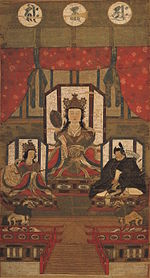Kukurihime
- View a machine-translated version of the Japanese article.
- Machine translation, like DeepL or Google Translate, is a useful starting point for translations, but translators must revise errors as necessary and confirm that the translation is accurate, rather than simply copy-pasting machine-translated text into the English Wikipedia.
- Consider adding a topic to this template: there are already 3,691 articles in the main category, and specifying
|topic=will aid in categorization. - Do not translate text that appears unreliable or low-quality. If possible, verify the text with references provided in the foreign-language article.
- You must provide copyright attribution in the edit summary accompanying your translation by providing an interlanguage link to the source of your translation. A model attribution edit summary is
Content in this edit is translated from the existing Japanese Wikipedia article at [[:ja:菊理媛命]]; see its history for attribution. - You may also add the template
{{Translated|ja|菊理媛命}}to the talk page. - For more guidance, see Wikipedia:Translation.
| Kukurihime-no-Kami | |
|---|---|
 | |
| Other names | Kukurihime-no-Mikoto (菊理媛命) Kikurihime Shirayama-Hime (白山比咩) Shirayama Hime no Kami (しらやまひめのかみ) Hakusan (白山) |
| Japanese | 菊理媛神 |
| Major cult center | Shirayama Hime Shrine |
| Texts | Nihon Shoki (Nihongi) |
| Gender | Female |
| Region | Japan |
| Festivals | Hakusan Festival |
Kukurihime no Kami (菊理媛神), also Kukurihime no Mikoto (菊理媛命), is a Japanese Shinto goddess[1][2] venerated as Shirayama Hime (白山比咩) (also known as Shirayama Hime no Kami (しらやまひめのかみ)) at Shirayama Hime Shrine in Hakusan, Ishikawa Prefecture.[1][3][4][5] She is equated with the mountain Hakusan (白山) in Ishikawa province at Hakusanhime shrine.[6] She is mentioned in the Nihongi (Nihon Shoki), but not in the Kojiki.[7][8] She mediated between Izanagi and Izanami after the former escaped from the land of the dead, Yomi no Kuni.[9] She is also venerated at Yasukuni Shrine in Tokyo and at Yōrō Shrine in Gifu Prefecture.[10][11] Kukuri appears very briefly during the myth of Yomi, after Izanagi used the great god Michikaeshi Ōkami to block the entry to Yomi no kuni. Her words are praised by Izanagi,[12] but what she said to him was not recorded (or erased),[13][14] despite Kukurihime's popularity as demonstrated by her worship at 3,000 shrines across Japan.[10][11] She was later merged with Kannon Bosatsu following Shinbutsu-shūgō ideas.[10][11][15]
References
- ^ a b Shinto Encyclopedia Volume One piece 264 (original 455 pages) [ Kukurihimenomomikoto Kikurihime]
- ^ Encyclopedia of the World Goddess pages 42-43 "Kukurihime Kikurihime"
- ^ Shirayama Hime Shrine history compilation committee edition "Hakusan Faith illustration" (Shirayama Hime Shrine, 2003)
- ^ Emperor Keishinkai Digital Collection, National Diet Library "Kokuzai Chusha Hakusanjo Shrine" "National Famous Shrine Photographs," Imperial Keishinkai, December 1922 .
- ^ Morokami Divine Festival Deity Dictionary pp. 446-447 "Shirayama Hime Shrine"
- ^ # Yama no reiryoku (Mountain spirit power) pp. 177-178 "Hakusan that Jomon people also danced to"
- ^ Tonerishin'nō-hen, edited by the National Diet Library Digital Collection "Nippon Shoki Vol. 30 (1)".
- ^ Hakusan Festival Shinko Volume 9 (Original page 8)
- ^ 川口, 謙二 (2012). 日本の神様読み解き事典. 柏書房.
- ^ a b c Brian Bocking, A Popular Dictionary of Shinto (Routledge, 2005).
- ^ a b c Stuart D. B. Picken, Historical Dictionary of Shinto (Scarecrow Press, 2010) p. 102.
- ^ Taro Sakamoto, Saburo Ienaga, Mitsusada Inoue, Shin Ono School Note "Nihon Shoki (1)" Iwanami Shoten <Iwanami Bunko>, September 1994.ISBN 4-00-300041-2 .
- ^ Kana Japanese Calligraphy First Volume 93 (Original page 38)
- ^ Apocalypse of the gods, pages 75-77, "Genealogy of the erased Hakusan dynasty"
- ^ # Mountain spirit power 180 pages
External links
- Kukurihime from Encyclopedia of Shinto
- v
- t
- e
 | This article relating to Shinto is a stub. You can help Wikipedia by expanding it. |
- v
- t
- e












